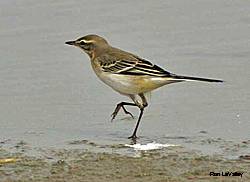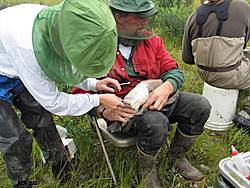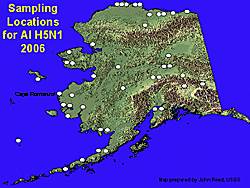Alaska Fish & Wildlife News
July 2006
Bird Flu and Wild Alaska Birds
Sampling Wagtails

A sparrow-sized bird with an innocent-sounding name – the Eastern Yellow Wagtail – has been identified as the wild bird most likely to carry the highly pathogenic H5N1 strain of avian flu from Asia to Alaska. The wagtails have arrived in North America and are now nesting in western Alaska. Scientists are capturing the little long-tailed birds and taking samples for testing. “It’s going well right now,” said Steve Matsuoka in late June. Matsuoka is with the U.S. Fish and Wildlife Service Migratory Bird Management Group. “We’re about halfway through the nesting period. We have a target of 100 adults, and it looks like we’ll be able to meet our sampling goal.” Wagtails are just one of more than two dozen species of birds that will be tested for avian flu viruses this summer. During nesting and migration, the captured wagtails and other target species will be aged, sexed, swabbed for actively shedding avian influenza virus, measured, banded, and released. There are many types of avian influenza viruses that circulate within wild bird populations without causing serious disease. Worldwide concern about the spread of the particular strain of avian influenza known as H5N1 HPAI (Highly Pathogenic Avian Influenza) is based on its lethality to domestic poultry flocks in Asia, where the disease developed. It has also shown an unusual ability to jump from birds to other species groups, but in its present form it has rarely infected humans. Although the H5N1 HPAI has spread across much of Asia, Europe, and Africa, it has not been detected in North America. Like all avian flus, H5 N1 HPAI is mostly spread between birds through fecal material. The virus may contaminate water and can then persist in the environment. It is easily killed by heat, drying and disinfectants, but not freezing, so it can possibly overwinter in the environment. This is not to say that it is certain that the highly pathogenic avian flu will be introduced to North America by wild birds. Health officials have stressed that so far, the virus seems to have spread throughout much of the Eastern Hemisphere primarily through the movement of poultry and poultry products such as chicken manure. There are other, more likely potential vectors for the virus. But to address the possibility, biologists have identified 28 species of migratory birds that might potentially contract the virus in Asia and carry it to Alaska this summer. “If it does get here (to North America) it may mean sick birds, but not necessarily sick people,” said wildlife biologist Matt Robus, director of the Division of Wildlife Conservation at the Alaska Department of Fish and Game. A team of scientists from several state and federal agencies, called the Alaska Interagency Avian Influenza Working Group, developed a system to evaluate and rank the birds. To prioritize which birds should be sampled for early detection of the virus, the birds were ranked according to five factors: 1) Proportion of the bird population occurring in Asia 2) Contact with a known “hot spot” or source 3) Habitats the birds use in Asia in context with potential for exposure – birds using offshore marine habitat being less likely than birds using terrestrial or freshwater habitats. 4) The population size in Alaska 5) The ability to obtain a representative sample of sufficient size Some birds spend time in areas where infected birds are known to occur. Other priority birds do not enter areas where infections have occurred, but cross paths with birds that do use those areas. Other Alaska birds, such as the low-scoring Gyrfalcon, may not migrate to areas where infections occur, but eat birds such as wagtails that do. The birds ranked from a low score of 8.5 to a high score of 17.5. The birds of concern range from small songbirds to large waterfowl. They include: Steller’s Eider (15), Northern Pintail (15), Lesser Snow Goose (15), Emperor Goose (13), Spectacled Eider (12), Black Brant (12), Lesser Sandhill Crane (11.5), Tundra Swan (11), Long-tailed Duck (10), Pacific Common Eider (10), King Eider (10), Aleutian Cackling Goose (11), Dunlin (17), Sharp-tailed Sandpiper (14.5), Bar-tailed Godwit (14), Ruddy Turnstone (13), Pectoral Sandpiper (13), Red Knot (12.5), Long-billed Dowitcher (12), Rock Sandpiper (11.5), Pacific Golden Plover (11.5), Buff-breasted Sandpiper (10), Gyrfalcon (8.5), Aleutian Tern (13), Glaucous-winged Gull (10.5), Glaucous Gull (11.5), Eastern Yellow Wagtail (17.5), Arctic Warbler (17) and Gray-cheeked Thrush (12). Biologists with expertise with four groups of birds – waterfowl, shorebirds, seabirds and passerines – then developed species-specific sampling plans. According to the ranking system, the Eastern Yellow Wagtail is the highest-ranking bird for the early detection of avian flu in North America, due to several potential risk factors. The wagtail overwinters in areas of Southeast Asia and Indonesia where outbreaks of avian flu have occurred. In addition, the wagtail uses open areas with fresh water, is often associated with agriculture and domestic animals, and congregates into large flocks at evening roosts. Wagtails could be infected through direct contact with wild or domestic birds in Asia and then carry the virus to Alaska, where almost one and a half million individuals of the species breed. Fortunately, biologists have already been studying the wagtail, which breeds in the coastal wetlands of western Alaska and in the foothills of the Brooks Range. Over the past decade, research and monitoring of wagtails has been done on Cape Romanzof, about 150 miles northwest of Bethel. The cape is defined by a range of hills called the Askinuk Mountains, which rise above the Yukon River Delta and overlook the Bering Sea. This summer, a crew of monitors is working out of the residential facilities at the Cape Romanzof Long Range Radar Site. A second field crew is working about 25 miles east of there at a remote field camp at Kagankaguti Lake, part of the Yukon Delta National Wildlife Refuge. “It’s a fascinating place, with the ocean on one side and this sea of wetlands stretching for miles and miles on the other. There's a unique community of birds there – lots of Asian migrants,” said Matsuoka. Both adult male and female wagtails are being captured. “We’re using a combination of mist nets and other nest traps, whatever works,” he said. “We’re trying various methods, depending on where they’re nesting. It depends on the habitat. On the steep slopes mist nets are good, in the low ground bow traps are better.” Matsuoka said in mid July they will begin targeting post-breeding birds, especially juveniles. Young birds with juvenile immune systems might be more susceptible to the virus. Although these young birds will not yet have visited Asia, they could be exposed to it by carriers, other birds moving through the population. “We’ll also be capturing lots of other different species, like the Gray-cheeked Thrush,” he said. “A portion (of the population) breeds in Russia and returns to Alaska in the fall.” Monitors hope to sample 200 juvenile and adult Eastern Yellow Wagtails this summer. Overall, the goal is to sample 19,000 live and hunter-killed birds in Alaska this year and collect another 1,500 fecal samples from wetlands where large numbers of birds mingle. Nationally, biologists plan is to sample between 75,000 and 100,000 wild birds. As of mid June, between 4,000 and 5,000 birds have been sampled in Alaska. The following state of Alaska website offers a great deal of information on avian flu: http://www.pandemicflu.alaska.gov


Subscribe to be notified about new issues
Receive a monthly notice about new issues and articles.
